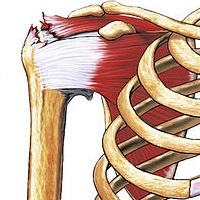
Photo from wikipedia
INTRODUCTION The primary aim of this study was to present patient-reported functional outcomes after zone 1 and 2 flexor tendon repair using a novel longitudinal volar approach crossing the distal… Click to show full abstract
INTRODUCTION The primary aim of this study was to present patient-reported functional outcomes after zone 1 and 2 flexor tendon repair using a novel longitudinal volar approach crossing the distal interphalangeal joint (DIPJ) perpendicularly. The secondary aims were to investigate the cosmetic outcomes, satisfaction and complication rates associated with this technique. METHODS Over a 6-year period, 75 patients underwent flexor tendon repair using this technique. The quick version of the Disabilities of the Arm, Shoulder and Hand (QuickDASH), five-level EQ-5D (EQ-5D-5L), Patient and Observer Scar Assessment Scale (POSAS) and satisfaction questionnaires were collected. QuickDASH scores were available for 59 patients (79%), and POSAS scores were available for 45 patients (60%) at a mean follow-up of 48 months. Concomitant nerve repairs were undertaken in 24 cases. RESULTS The median QuickDASH score was 4.5 (interquartile range [IQR] 1.1-12.5) and median POSAS score was 12 (IQR 8-16). No significant difference was observed in median QuickDASH score between patients with and without a concomitant nerve repair (4.5 vs 6.8; p = 0.36). Fifty-six patients (94%) were satisfied. Two patients required open tenolysis, and a single case of early re-rupture occurred that required revision open repair. CONCLUSIONS Utilising validated patient-reported functional outcomes, this study demonstrated that a direct longitudinal incision over the DIPJ for zone 1 and 2 flexor tendon repairs can result in excellent functional and cosmetic outcomes, with high rates of patient satisfaction and low rates of complications. This challenges previously held dogma that longitudinal incisions crossing flexion creases should be avoided.
Journal Title: Annals of the Royal College of Surgeons of England
Year Published: 2022
Link to full text (if available)
Share on Social Media: Sign Up to like & get
recommendations!